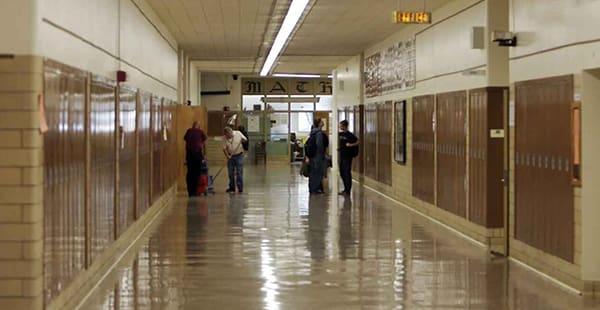01. Asbestos Use
How Was Asbestos Used in Schools?
Asbestos was commonly used in fire-resistant materials found in schools, such as asbestos cloth, asbestos board and thermal systems. Schools also used asbestos construction products. Some schools had lab equipment that had asbestos in them. Asbestos is durable and resistant to heat, making it a popular additive to many products.
Locations in schools where asbestos was used include:
- Auditoriums
- Boiler rooms
- Classrooms
- Restrooms
- School corridors
- Storage areas
- Teachers’ lounges
As of 2024, the average age of U.S. schools is about 49 years. Nearly half of all U.S. primary and secondary school buildings were built between 1950 and 1969. During these years, asbestos use continued to climb toward its peak in 1973 of over 800,000 tons per year.
The Environmental Protection Agency (EPA) released a study on asbestos in schools in 1984. The EPA found exposure risks in nearly 35,000 schools. An estimated 15 million students and 1.4 million faculty and staff may have been exposed.
The federal government began regulating asbestos use in the 1970s. Although asbestos regulations decreased its use, asbestos may still be in older schools.
Asbestos remains a health risk to anyone who works in or attends an older school. If asbestos becomes damaged or worn, untrained people should not handle it. School faculty and staff should avoid the area and contact a school administrator. The administrator can call an abatement professional to address the issue.
Asbestos exposure may lead to diseases like mesothelioma. This type of cancer has a long latency period, meaning symptoms show up years after exposure. Mesothelioma’s symptoms may show up 10 – 50 years after exposure.
02. Notable Schools
Notable Schools That Used Asbestos
Many schools nationwide have had asbestos problems. For example, the Philadelphia School District began closing schools in 2018 because of asbestos. As abatements were completed, those schools reopened. Many other schools and school districts have also faced asbestos concerns.
Asbestos in California Public Schools
Asbestos has been found in several California schools, exposing hundreds of students. Some notable instances include:
- El Camino High School: A 1986 report states workers removed asbestos from the ceilings of this Oceanside school. A 2023 roof inspection came back negative for asbestos.
- Mira Costa High School: After receiving complaints in 2018 that contractors disturbed asbestos at this Manhattan Beach school, the South Coast Air Quality Management District served the school district with 27 violations. These violations included failing to have an asbestos management plan.
- Ocean View School District: Three elementary schools in Huntington Beach had to bus 1,600 students to other schools after finding asbestos on site. The district closed the schools in 2014 and reopened the last one in 2016.
- Roosevelt High School: In 2018, inspectors found asbestos at this Los Angeles school. A contractor came across steam piping wrapped in asbestos insulation during a $173 million modernization project.
As California schools continue to age, more buildings may need asbestos abatement.
Asbestos in Illinois Public Schools
Asbestos has been found in a number of Illinois schools. For example, advocacy groups analyzed school records from 2013 for the Chicago area. The analysis showed extensive exposure risks. Over 180 schools had damaged asbestos products or products at risk of being damaged in them, including:
- Helen M. Hefferan Elementary School in Westfield Park
- Lincoln Park High School in Lincoln Park
- Northwest Middle School near Hanson Park
More than 1,100 locations within these schools had asbestos. Inspectors recommended having friable (easily crumbled) asbestos products removed from over 600 of those locations.
In a 2015 update, the district noted only 11 of 184 schools had complied with the inspectors’ recommendations. The remaining schools still had dangerous asbestos.
Outside the Chicago area, asbestos has been found in other school buildings, like:
- Ridgeview Junior High School: An abatement project started at this Colfax school in 2022. Inspectors found asbestos insulation on piping in the mechanical room. They also discovered asbestos in the glue under the floor tiles.
- Washington Elementary School: In 2021, an abatement project took place at this school in Dixon to remove asbestos flooring.
Asbestos in Iowa Public and Private Schools
Asbestos-containing materials have been found in schools throughout Iowa. Iowa schools and districts in the news for asbestos include:
- Jefferson High School: In 2017, the EPA opened a criminal investigation into unsafe working conditions discovered during a 2013 asbestos removal project at this school.
- Kennedy High School: In 2020, the Iowa Department of Natural Resources issued a violation notice to this school in Cedar Rapids. Workers who removed damaged floor tiles did not follow abatement regulations, potentially exposing workers and others.
- North Linn Community School District: The Occupational Safety and Health Administration (OSHA) and Iowa Department of Natural Resources fined this district $76,000. They found the district exposed employees and workers to asbestos — even after a warning to vacate the premises.
- St. Mary’s Catholic School: This school in Waterloo underwent asbestos testing in early 2025.
Asbestos in New Jersey Public Schools
The New Jersey Department of Health has monitored and assessed school testing and abatement since 1988. A 1991 study of 17 schools found 45% of those undergoing asbestos removal had elevated airborne asbestos levels. Workers and others faced exposure risks.
Asbestos in New York Public Schools
A number of districts in New York have faced issues with asbestos in their schools, including:
- City School District of Albany: Albany High School has undergone several asbestos abatement projects. From 2020 to 2023, workers performed abatements in the pool area, the athletics area and a building near one of the parking lots.
- Yonkers Public School System: In 2004, this school system reached a settlement with the EPA over asbestos violations. The system agreed to spend over $100,000 to bring its 43 schools into compliance with federal asbestos regulations. Then, from 2017 to 2020, workers performed abatement projects at Roosevelt High School, Yonkers Middle High School and Saunders Trades and Technical High School.
Asbestos in Pennsylvania Public Schools
In Pennsylvania, two school districts have faced asbestos scandals in recent years. Asbestos contamination was found in several locations, including classrooms, restrooms and cafeterias.
- Philadelphia School District: The district has closed several schools. During inspections, millions of asbestos fibers were found in elementary schools. Then, during the 2019 – 2020 school year, 11 Philadelphia School District schools were closed because of asbestos contamination, including Benjamin Franklin High School and its magnet school, the Science Leadership Academy. Frankford High School closed in 2023. The district planned a $19.9 million investment to get the school reopened for the 2025 – 2026 school year.
- Scranton School District: In 2016, routine inspections in the district uncovered 70 instances of asbestos materials. Several district officials chose to hide the matter from other officials, staff, parents and students.
Asbestos in Virginia Public Schools
A notable instance of asbestos in Virginia occurred at Central High School in Painter. The school closed in 2005 and was later sold to a furniture designer. He spent $50,000 on asbestos removal before listing the building for sale in 2015.
03. Who Is at Risk?
Who Is at Risk of Exposure in Schools?
Schools are considered asbestos jobsites. Asbestos use in schools has exposed many people to the harmful mineral. Teachers and school staff face exposure risks on the job. Students also face the same risks as people who work there.
Not only can people in these buildings be exposed, but they can bring asbestos home on their clothing or in their hair. This asbestos can harm household members. When this happens, it is known as secondary exposure.
Student Asbestos Exposure Risk
All ages of schoolchildren may be in danger of asbestos exposure. And they may be at an increased risk. The EPA Office of Inspector General noted this is because children:
- Are more active, meaning they may breathe harder more often
- Are more likely to breathe through their mouths
- Are more likely to put things in their mouths (such as toys, crayons and other products that could contain asbestos)
- Breathe faster than adults
- Tend to spend more time on the floor, where asbestos fibers are likely to settle
An EPA report suggested childhood exposure could increase the risk of developing mesothelioma.
Students Exposed to Asbestos in School Supplies
Many children’s products may have asbestos in them. For example, investigators found asbestos in makeup marketed to children. Some common school supplies may also have asbestos.
In 2018, investigators discovered asbestos in packs of crayons. The contaminated Playskool crayons were sold in dollar stores and online. In a similar incident three years earlier, an investigation revealed that dollar stores sold multiple brands of asbestos-contaminated crayons.
Teacher Asbestos Exposure Risk
School teachers have rates of mesothelioma comparable to high-risk asbestos occupations.
Data from the National Institute for Occupational Safety and Health (NIOSH) shows the dangers for teachers. This data shows teachers have a proportionate mortality ratio of 2:1. This mirrors asbestos occupations like plumbers and mechanical engineers.
With asbestos common in schools, millions of people have faced exposure risks. As a result, students, teachers and staff may be at risk of developing asbestos diseases. These could include mesothelioma, asbestosis and asbestos-related lung cancer.
04. Asbestos Lawsuits
Asbestos Lawsuits and Compensation
Asbestos in schools has led to legal action. Anyone diagnosed with an asbestos-related disease may be able to file an asbestos lawsuit. These lawsuits may result in a verdict or mesothelioma settlements.
With school exposure, the alleged responsible parties (or defendants) can vary. In some cases, the person with an asbestos disease may file a lawsuit against the school district. An example from 2019 shows one such case:
- A 51-year-old former teacher developed mesothelioma from school asbestos exposure. She had taught in the Philadelphia School District for 28 years. Before the case made it to court, the school district settled with her for $850,000.
People who develop asbestos diseases may also be able to file lawsuits against asbestos product manufacturers. Many asbestos companies manufactured products used in schools. If someone with an asbestos disease can tie their exposure to a specific product, they may be able to get compensation.
Experienced mesothelioma lawyers can help. These attorneys have the knowledge and resources to explain legal options and handle asbestos cases.
05. Asbestos Exposure Precautions
Minimizing Asbestos Exposure in School
Federal and state governments have established regulations to help prevent asbestos exposure. For example, the U.S. Congress passed the Asbestos Hazard Emergency Response Act (AHERA) in 1986.
AHERA applies to public school districts, non-profit schools and religious schools. It requires districts to follow specific guidelines to reduce exposure risk. These guidelines state:
- All schools must have their buildings inspected. The initial inspection should note all asbestos-containing materials (ACMs). If the inspection finds ACMs, districts must inspect all buildings every three years.
- Any school with ACMs must develop an asbestos management plan. Administrators must keep these plans at the school for any parents and staff to see. They also must notify parents, staff and teachers of any planned or in-progress asbestos work.
- Custodial staff must receive asbestos awareness training.
According to AHERA, materials and products in good condition can be considered safe. But a designated person who understands AHERA requirements should monitor them. This person must ensure the district follows AHERA guidelines when the materials show signs of wear or damage.
These rules do not extend to private for-profit schools. Colleges are also not covered under AHERA rules.
Legal Ramifications for Violating Rules About Asbestos in Schools
Government agencies may notify schools of violations for failing to follow asbestos regulations. Agencies can give violations when school districts or administrators do not fix asbestos problems despite knowing about them.
For example, the Mira Costa High School violated asbestos regulations. Contractors for the school used a power grinder on asbestos flooring in the library with students and others present. Once South Coast Air Quality Management District (AQMD) learned of this work, they notified the district and contractors of 27 violations. South Coast AQMD had the authority to levy fines against the Manhattan Beach school district.
School officials may also face criminal prosecution for behaviors such as failing to notify students, teachers and staff.
Asbestos abatement professionals should be the only ones who remove asbestos. Regulations help ensure the asbestos abatement process is effective and safe. When followed, regulations can reduce health risks for students, teachers and the general public.







